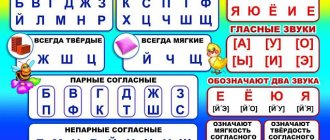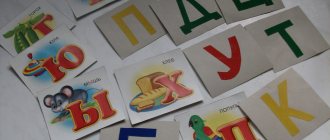- Hard and soft consonants
- Voiced and voiceless consonants
- Hissing and whistling consonants
- Letter and sound Y
The Russian language has 21 consonants and 37 consonant sounds:
| Letter | Sounds | Letter | Sounds | |
| B | [b], [b'] | P | [p], [p'] | |
| IN | [in], [in'] | R | [р], [р'] | |
| G | [g], [g'] | WITH | [s], [s'] | |
| D | [d], [d'] | T | [t], [t'] | |
| AND | [zh], [zh'] | F | [f], [f'] | |
| Z | [z], [z'] | X | [x], [x'] | |
| Y | [th'] | C | [ts] | |
| TO | [k], [k'] | H | [h'] | |
| L | [l], [l'] | Sh | [w] | |
| M | [mm'] | SCH | [sch'] | |
| N | [n], [n'] |
Consonant sounds are hard and soft, voiced and voiceless. The softness of sound in transcription is indicated by [' ].
Classification of consonants
By noise level:
| By noise level | |
| Sonorous | — voice predominates, noise level is insignificant - [l], [m], [n], [r], [th]; |
| Noisy | - significant noise level. Noisy ones are divided into:
|
| By hardness | |
| Solid | [l], [d], [s], [g], [ts], [w], etc. |
| Soft | [l,], [d,], [s,], [w,], [h,], [th], etc. |
Among the voiced consonants, there are 9 sounds in which there is more voice than noise. These are sonorant sounds.
ADVICE FOR PARENTS
The topic “Sounds and letters in the Russian language” will not be difficult if students immediately understand the material. Having learned to independently analyze the sound side of speech, schoolchildren are attentive to the correct spelling of words, which leads to a qualitative increase in their knowledge. It will not be difficult for an adult to consolidate the learned material together with the child. You can do this at almost any time: while walking, traveling, talking, etc. And special word games will help. Come up with a verbal double, replacing one sound; compose a word in which everything is pronounced only firmly or, conversely, only softly; come up with a word that has more letters than sounds... There are many options for games, the child himself can become the author of such entertainment. The benefits of word games and fluency will definitely impact your lessons!
Definition
Sonorant sounds are voiced consonant sounds in which the voice dominates the noise. The word “sonorous” comes from the Latin – “sonorous”, which translated into Russian means “sonorous”. The sonorant group includes eight paired softness-hardness ones and one soft unpaired one: [l] - [l'], [m] - [m'], [n] - [n'], [r] - [r '], [th].
Sonorous sounds, as a rule, are formed with the participation of the lungs, vocal cords, lips, tongue, and palate. Teeth are not involved in their formation. According to the place and method of formation, they are: labiolabial - [m], [m']; lingual-labial – [n], [n']; lingual-palatal – [l], [l'], [r], [r'], [th']. In terms of sound strength, they are all voiced.
Let's remember
Now let's move on to methods of studying and memorizing. 1st grade remembers hard consonants reluctantly - it’s too boring. But there is always a way to increase efficiency by getting the student interested in an unusual form of work, even with material that is so theoretical and unnecessary, at first glance. Various pictures, diagrams, drawings and games with word choice will come to our aid.
Let's make cards, perhaps. You will need two sheets of colored paper or colored cardboard. The main thing is that they are contrasting. We cut out identical clouds, balls, figures - whatever comes to your mind. Then we connect the two figures with glue so that these very contrasting sides are on the outside. And then, with the participation of your little assistant, on one side we write vowels that are friendly with soft consonants, and on the other - with hard consonants. In order not to forget anything at all, you can also place unpaired and paired ones next to each other, respectively. When everything is at hand, it is much easier.
Next, we draw something that can help create an association - a brick on cardboard with hard sounds written on it, and a feather with soft phonemes. Or something else like that. Having a concrete example before his eyes, the student will certainly learn the information better. Later, for reinforcement, you can ask your student to highlight hard and soft sounds in written words in different colors - red and blue, for example, so that you can easily check his homework.
Unpaired voiced sonorants
As noted above, all sonorants belong to voiced consonant sounds. Unlike most voiced consonants, sonorant sounds do not have voiceless pairs. If other consonants, such as [d], [d'], [b], [b'], [z], [z'] and others have paired voiceless [t], [t'], [p] , [p'], [s], [s'], then the sonorant sounds [l], [l'], [m], [m'], [n], [n'], [r], [ р'], [й'] do not have such a pair among voiceless consonants. All sonorant sounds according to this feature are unpaired. They are not deafened in any position: neither at the end of a word, nor before voiceless consonants. They are always pronounced loudly - with vocal force, and ordinary paired consonants at the end of a word and before voiceless consonants are pronounced dull.
This is easy to check by comparison:
"home": before
[m] – “frost”: moro [s]; “day”: de[n'] – “copper”: me[t']; “breakdown”: shelf[m]ka – boat: boat[t]ka; “slice”: do[l']ka – “radish”: re[t']ka.
- The consonants R, L, M, N, J are called sonorant.
- All only voiced, unpaired consonants help to remember the phrase:
LEMON IS PARADISE!
If you delete all the vowels in this sentence, then only voiced, unpaired consonant sounds will remain.
| Hard sonorous sounds | Sonorant sounds, with the exception of the sound [th'], have a pair of hardness: [l] - [l'], [m] - [m'], [n] - [n'], [r] - [r' ]. In certain positions they can be pronounced both softly and firmly: “elk”: [l]os – “salt”: so[l']; “mol”: [m]mol – “mel”: [m']mel; “bottom”: d[n]o – “day”: de[n’], “lynx”: [r]lyx – “door”: two[r’]. The sound [y'] is not pronounced firmly under any circumstances, and does not have a hardness pair: “egg” - [y'ay'tso]. It's just soft. In its sound, it is the closest of the sonorant sounds to vowel sounds, especially close to - [and]. Sometimes it is even called “and - short” |
| Voiced sonorant consonants | All sonorant sounds are only voiced sounds, there are no dull sounds among them!!! |
| Voiceless sonorous sounds | There are no dull sounds among sonorants!!! |
| Hissing sonorous sounds | There are no hissing sonorous sounds!!! |
Whistling and hissing sounds: production and automation presentation on speech therapy
Slide 1
Whistling and hissing sounds: production and automation
Slide 2
Articulation of sounds Whistling [s] - consonant, oral, voiceless, fricative, anterior lingual, hard [z] - consonant, oral, voiced, fricative, anterior lingual, hard [s '], [z '] - soft [ts] - consonant, oral, deaf, occlusive-fissure, anterior lingual, hard - the lips are smiling - the teeth are brought together - the tip of the tongue rests on the lower incisors, the back is moderately curved, the lateral edges from the inside are pressed against the upper molars, a groove is formed in the middle of the tongue through which a cold stream of exhaled air passes . With [ts], the tip of the tongue is behind the lower incisors, and the back closes with the alveoli and, after an explosion of air, falls to the position of the sound [s]. Sibilant [w] – consonant, oral, voiceless, fricative, anterior-lingual, hard [zh] – consonant, oral, voiced, fricative, anterior-lingual, hard [sch] – consonant, oral, voiceless, fricative, anterior-lingual, soft [h] – consonant, oral, voiceless, occlusive-frictional, anterior lingual, soft - the lips are elongated into a wide tube - the teeth are 3-4 mm apart - the wide tip of the tongue in the shape of a cup is raised to the front of the hard palate, but does not touch them. The lateral edges of the tongue touch the upper molars. - warm air stream With [ sch ] the tip of the tongue is raised as with [ w ], but not to the front of the hard palate, but to the alveoli, forming a narrowing in this place. With [h], the wide tip of the tongue in the shape of a cup is raised to the upper alveoli, at the first moment of articulation it forms a stop with them. At the second moment, it moves to a position close to the sound [w], forming two physiological constrictions.
Slide 3
Disadvantages of the pronunciation of whistling sounds Disadvantages of the pronunciation of whistling and hissing sounds are called sigmatism, the replacement of whistling sounds with hissing or other sounds of the Russian language is called parasigmatism. Sigmatisms - Interdental sigmatism (the tip of the tongue is in the position between the teeth) - Labial-dental sigmatism (there is no smile, the child closes the lower lip with the upper incisors, the sound [f] appears) - Lateral sigmatism (the lateral edges of the tongue are not pressed against the molars, the tongue narrow, the air stream does not go in the center, but along the sides of the tongue) - Nasal sigmatism (the stream of exhaled air goes through the nasal passages) - Dental sigmatism (the tongue rests on the closed teeth, a sound like a plosive [t] is heard, when ringing - [d] ) - Hissing sigmatism (the tongue takes on the articulation of a softened hissing sound, reminiscent of a shortened [ ш ])
Slide 4
Disadvantages of the pronunciation of whistling sounds Parasigmatisms Replacing [s] with [s '] (syumka, syapogi) - the back of the tongue is too raised Replacing [s] with [t] (tumka, autobut) - the back of the tongue forms a stop with the palate Replacing [s] with [ z] (zumka, zapogi) Replacing [s] with [sh] (Shumka, shad) Replacing [s] with [x] (khumka, had) [z] – [z '], [z] – [d], [z] – [s], [z] – [zh], [z] – [g,x], [z] – [v,t,ts] [ts] – [t], [ts] – [ s], [ts] – [h], [ts] – [sch], [ts] – [s '], [ts] – [w]
Slide 5
Disadvantages of pronouncing hissing sounds The same as with whistling sounds, except for hissing, but there is buccal sigmatism (pronunciation of the sound is accompanied by swelling of the cheeks) and lower pronunciation of hissing sounds. Parasigmatisms (replacements) [w] - [s], [w] – [s '], [w] – [t], [w] – [x], [w] – [f] [z] – [z ], [zh] – [z '], [zh] – [d], [zh] – [g], [zh] – [v] [sch] – [t’], [sch] – [s’ ] , [ sch ] – [ w ] [ h – t '] , [ h ] – [ sch ] , [ h ] – [ t ], [ h ] – [ x ]
Slide 6
Stages of work on any sound: preparatory stage: sound production; its automation in syllables, words, phrases, sentences and stories; differentiation with replaceable or mixed sounds;
Slide 7
Preparatory stage Development of phonemic hearing introduction of an emotional image of sound materialization of it in the form of a picture analysis of articulatory characteristics of sound analysis of phonetic characteristics of sound Formation of the correct structure of articulatory organs using a complex of articulatory gymnastics for the lower structure: holding the tip of the tongue behind the lower teeth resistance of the tip of the tongue relaxing the back of the tongue raising and lowering the back of the tongue producing a long, smooth air stream
Slide 8
Methods of producing sounds imitation mechanical assistance (special speech therapy probes are used) mixed (imitation + mechanical assistance) bypass (based on preserved or already corrected sounds)
Slide 9
A set of exercises for whistling sounds “Fence” Stretch your lips in a smile, exposing the upper and lower teeth, which stand on top of each other like a fence. Say “I” to yourself. Hold this for a count from 1 to 10. “Tube” Round your lips and extend them forward, as when pronouncing the sound “O”. Hold the count from 1 to 10. Relax your lips and repeat the exercise several times. Alternate “Fence” - “Tube” “Let’s punish the naughty tongue” Open your mouth a little, calmly put your tongue on your lower lip and, spanking it with your lips, pronounce the sounds: “five-five-five”, and then bite with your teeth: “cha-cha- cha." “Pancake” Smile, the wide tongue lies motionless, does not tremble on the lower lip, touching the corners of the mouth, the upper teeth are visible. Hold while counting from 1 to 1 0. “Let’s cool the pancake” Smile, make a pancake, blow, pronouncing the sound “F” for a long time, do not puff out your cheeks.
Slide 10
A set of exercises for whistling sounds “Let's brush the lower teeth” Make a smile, open your mouth slightly, move the tip of your tongue behind the lower teeth left and right, the lower jaw does not move (the teeth can be brushed both outside and inside). “Slide” (“Coil”, “Pussy is angry”) Open your mouth slightly, rest the tip of your tongue on the lower teeth, raise the back of the tongue, press the side edges to the upper molars. Hold for 15 seconds. Bite the back of your tongue, then slide your teeth down the tongue (ride down the slide). "Tube" from the tongue. “Magic wand” Smile, open your mouth and press the tense tip of your tongue against your lower teeth. Place a stick (counting stick or match) along the middle of the tongue and, closing your teeth, forcefully blow out air evenly. A long “C” sound should be heard. Repeat the exercise with and without a stick.
Slide 11
A set of exercises for hissing sounds “Let's punish the naughty tongue” “Pancake” “Let's cool the pancake” “Tasty jam” Imaginary jam is licked with the tongue from the upper lip with vertically oriented movements. That is, the tongue moves from top to bottom and into the mouth, and not along the lip. The mouth is slightly open, the lips are closed around the tongue. “Cup” The starting position is “pancake”, the mouth is slightly open (the jaw is lowered, the lips form the letter O). The tongue should be torn off from the lower palate, its lateral edges should be lifted and held in this position for 10 seconds. You can imagine that the tongue is a vessel with water that cannot be spilled. “Focus” Smile, open your mouth slightly, place the wide front edge of the tongue on the upper lip so that its side edges are pressed and there is a groove in the middle of the tongue, and blow off the cotton wool placed on the tip of the nose. The air should go in the middle of the tongue, then the fleece will fly up.
Slide 12
A set of exercises for hissing sounds “Swing” The mouth is open, the lips are in a half-smile, the teeth are visible. The tongue is relaxed, lies on the lower palate, resting its tip on the back of the lower teeth. Every five seconds the tongue changes position, resting the tip against the upper teeth and back. The jaw and lips remain completely motionless. “Let's brush the upper teeth” Open your mouth and use the tip of your tongue to “clean” the upper teeth from the inside (outside) side, moving your tongue from side to side. The lips are smiling, the upper and lower teeth are visible. The lower jaw is motionless, only the tongue works. “Toffee” Place the wide tip of your tongue on your lower lip. Place a thin piece of toffee on the very edge of your tongue and glue a piece of candy to the roof of your mouth behind your upper teeth.
Slide 13
Production of whistling sounds By imitation (demonstration of correct articulation is used) [S] - game “Pump”, water song, light breeze [Z] - a mosquito, fly or wasp rings [C] - titmouse song, “Quiet, the children are making noise!” From supporting sounds Sound [s] - from [and] - sing the sound, and then blow a cold breeze - from ta-ta-ta, cha-cha-cha, ti-ti-ti - and blow a cold breeze Sound [z] from sound [s], control of the vocal cords Sound [ts] affricate, from consists of two sounds: t – s, t-s, ts, ts Mixed method Stretch your lips into a smile, bite your wide tongue with your teeth, say “t-t-t "and let in the breeze. As the exhalation lengthens, the sound [t] turns into the sound [s]. You need to use a probe to lay a “groove” along the middle part of the tongue. After exhaling correctly, the tongue is gradually moved behind the teeth. Perform the “Fence” exercise, say “and-and-and”; then exercise “Cold wind” - “ssss”, hold the tip of the tongue with a probe (iiiiiiissssss).
Slide 14
Making whistling sounds Mechanical method 1. With interdental sigmatism, the child is asked to lower the wide tip of the tongue behind the lower teeth and “blow” a long, light breeze. If the sound [s] is not pronounced clearly enough, then use a special probe or the tip of a spatula to press the tip of the tongue, lowering it slightly behind the lower incisors. 2. For labiodental sigmatism, pronounce the sound [s] with the lips parted and the edges of the incisors exposed. If the child cannot reproduce this position of the articulation organs himself, then the speech therapist holds the child’s lower lip, exposing the incisors. 3. In case of lateral sigmatism, the correct sound [s] is achieved with the interdental position of the tongue, then the tip of the tongue is moved behind the lower incisors.
Slide 15
Making whistling sounds Mechanical method 4. Dental sigmatism is corrected in 2 ways: - Lightly pressing the spatula (probe) on the tip of the tongue, lower it behind the lower teeth to form an outlet for air through the interdental gap. — Invite the child to hold his tongue between the incisors, spreading it wide. With this position of the tongue, the child, exhaling air, feels its stream at the tip of the tongue, producing a sound similar to interdental [s], then, lightly pressing the spread tongue with a spatula, on its tip, one should gradually move it behind the lower incisors. 5. For hissing sigmatism, we suggest the child blow on the tongue in an interdental position. It is recommended to linger as long as possible at the stage of interdental pronunciation of the sound [s] in syllables, words, and phrases. When the tongue is finally strengthened in this position, you can gradually move the tip of the tongue behind the lower incisors, which usually happens automatically.
Slide 16
Production of whistling sounds Mechanical method 6. When eliminating nasal sigmatism, it is necessary to form a correct exhalation through the middle of the oral cavity, to differentiate the nasal and oral exhalation. Then the child is asked to blow on his tongue in an interdental position. They automate interdental sounds in syllables and words, and then eliminate interdental sigmatism. To pronounce the sound [z], the speech therapist suggests that the child turn on his voice while pronouncing the sound [s]. When setting the sound [ts], the child is asked to pronounce the sounds [t] and [s] in a row, first slowly, and then accelerating the pace, achieving a continuous transition from the sound [t] to [s] (ts – ts), we make sure that the child does not pronounce TPP or THOUSAND. We start automating with the reverse syllables ATs, OTs, UC. The softness of the sounds [s '] and [z '] is achieved mechanically by moving the tip of the tongue back into the depths of the mouth. The back of the tongue rises.
Slide 17
Production of hissing sounds By imitation (demonstration of correct articulation is used) [Ш] - like a hissing goose, a snake, rustling like a reed [Zh] - a bee buzzes, a beetle [Ш] - the song of a brush sch-sch-sch. [H] – little train song chchchh. From supporting sounds Sound [w] - from [s] - pronounce the sound [s] and raise the tongue up. - from [r] - pronounce this sound loudly, then in a whisper, stop the vibration yourself or with a spatula. Sound [sch] from the sound [sh], moving the tongue forward, closer to the teeth. The sound [h] is an affricate, from consists of two sounds: t ' - sch, t ' - sch, t ' sch, h Mixed method The lips are rounded and slightly pushed forward, the tongue is in the shape of a “cup” behind the upper teeth, let in a warm breeze, holding your tongue with a probe or spatula...
Slide 18
Making hissing sounds Mechanical method The child pronounces the sound [s] several times and the speech therapist inserts a spatula (probe) under the tongue. With its help, it moves the tip of the tongue to the upper position and regulates the degree of its rise until a normal-sounding sound [sh] appears. 1. In case of interdental sigmatism, the child is asked to pronounce [t] with an open mouth at a slow pace 4-5 times, hitting the tubercles behind the upper teeth with the tip of the tongue; Gradually lengthen the exhaled stream and do not hit the tubercles, but only raise the tip of the tongue towards them. 2. For labiodental sigmatism, place [w] by imitation, using visual control. Make sure that the lower lip is motionless and exposes the lower incisors (the lips can be held with your finger). Mechanical reception from [s] is possible. 3. For lateral sigmatism, mechanical assistance is used (a probe, a flat, narrow, slightly curved handle from a teaspoon), the wide tongue is lifted by the upper teeth, pushed back to the tubercles, the child is asked to lightly clamp the spoon with his teeth and pronounce [s] for a long time ( front teeth are always visible).
Slide 19
Making hissing sounds Mechanical method 4. With dental sigmatism, the ability to compare and distinguish by ear [w] - [t] is developed, based on tactile sensations of an air stream ([w] - long, [t] - jerky). Exercises are carried out for a long-term directed air stream. The procedure is similar to when correcting labiodental sigmatism. 5. With hissing parasigmatism, they are taught to compare and distinguish [w] - [sch] by ear, the ability to raise the wide front edge of the tongue to the tubercles behind the upper incisors is developed; alternate movements of the wide tip of the tongue from the base of the upper incisors to the front of the hard palate (forward - backward). Setting from [with] a mechanical technique (pushing the tongue back). 6. For whistling parasigmatism, learn to compare and distinguish [s] - [w] by ear, to distinguish the difference in air flow ([s] - cold, [w] - warm); practice upward movements of the wide tongue; alternating movements of the wide tongue over the lower – upper teeth; alternating lip movements (smile - tube). Production by imitation or mixed method.
Slide 20
Making hissing sounds Mechanical method 6. When eliminating nasal sigmatism, the ability to hold a wide, spread tongue on the upper lip is developed; direct the air stream to the tip of the tongue raised on the upper lip; to distinguish by ear the sound [w] in nasal and oral pronunciation, first the sound [s] is practiced, then the [w] is mechanically placed. 7. Buccal and lower pronunciation are eliminated mechanically and in a mixed way. To pronounce the sound [zh], the speech therapist suggests that the child turn on his voice while pronouncing the sound [w]. Need to remember!!! When introducing any sound, you should not name it to your child, so as not to cause him to habitually mispronounce it.
Slide 21
Setting the sound Ш The sound [у] often appears in a child’s speech automatically after setting the sounds [Ш], [Х] and [Ч]. 1. From the sound [s ']. When pronouncing [s '], lift your tongue up and stretch your lips forward. Use a spatula (probe) to hold the tip of the tongue at the top. 2. From the syllable as. When pronouncing as, lift your tongue up and release a sharp, strong stream of air, pressing on your cheeks. Use a spatula (probe) to hold the tip of the tongue at the top. 3. From the sound [w]. When pronouncing [sh], move your tongue a little forward, closer to the teeth. 4. From the sound [h]. Ask your child to pronounce the sound [h] in a drawn-out manner and pay attention to what hissing sound he hears. A long sound [sh] is heard. Setting the sound Ch 1. From the sound [t ']. The child pronounces the sound [t '], while the tip of the tongue is slightly moved back with a spatula (probe, spoon handle). 2. From the syllable at. The child pronounces the syllable at and at this time, placing a spatula under the front edge of the tongue, lift it up to the alveoli. 3. When the child repeatedly pronounces the syllable ti, press the thumb and forefinger on the cheeks, pressing them to the molars. Chi will be heard.
Slide 22
Automation of whistling and hissing sounds






